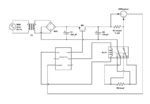joshmnky
Newbie level 2
First off, I have no experience making circuits. I burned through a Sunday, morning to night, to try and understand power supplies enough to get this far.
My question is whether or not the circuit shown below will work. The purpose is to serve as a cheap programmable current source for electroforming, which will require 1-10 amps depending on how big the part is. This schematic shows the arduino acting as an ammeter with the help of a differentiating op amp. I have a relay before the load so I can switch the current direction intermittently (makes crystal structure finer and less porous).

Any obvious flaws? Am I missing huge concepts? Easier ways of doing things?
My question is whether or not the circuit shown below will work. The purpose is to serve as a cheap programmable current source for electroforming, which will require 1-10 amps depending on how big the part is. This schematic shows the arduino acting as an ammeter with the help of a differentiating op amp. I have a relay before the load so I can switch the current direction intermittently (makes crystal structure finer and less porous).

Any obvious flaws? Am I missing huge concepts? Easier ways of doing things?